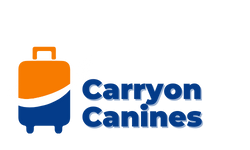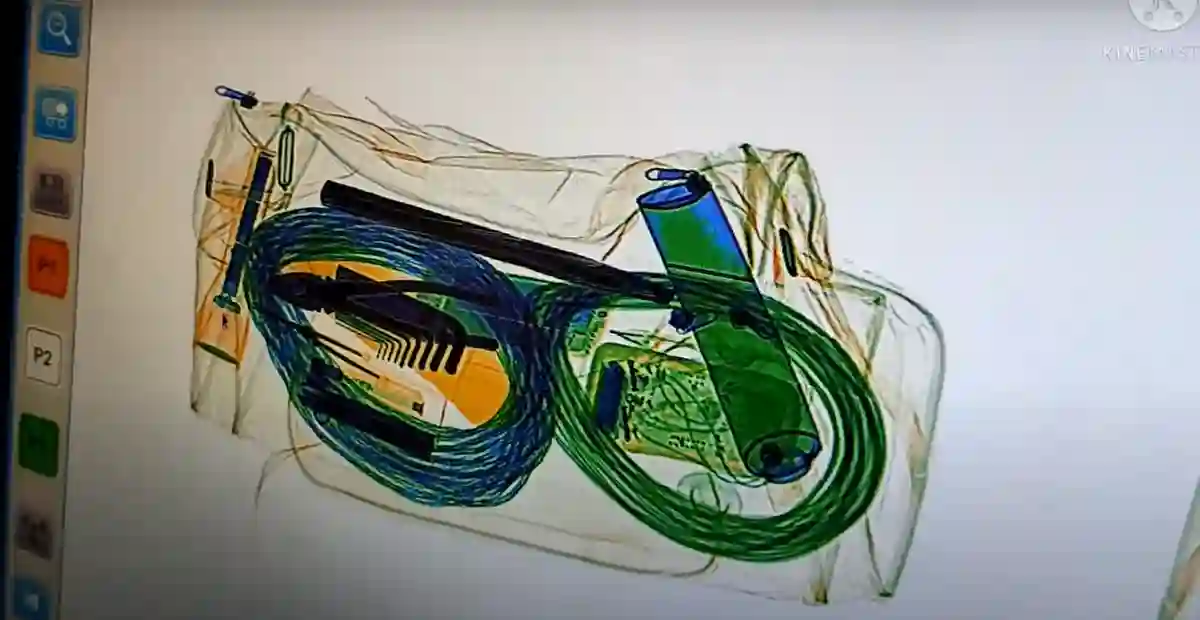How do airport scanners detect drugs in luggage? Find out how we close our skies to keep you safe with this cutting-edge technique and what you never knew about it. The things they flag are suspicious: You won’t believe what happens when they do!
Q: How does airport security identify illegal drugs in bags? The approach may seem simple, but in the back of every scan is a team of sophisticated technology and expertise meant to catch even the smallest traces of contraband. An understanding of how airport scanners operate can actually demonstrate how safe contemporary air travel is.
Airport scanners are hardly just machines that “look” through bags. Such devices employ intricate algorithms to determine the makeup of luggage contents, searching for materials commonly associated with drugs. Kicking that can down the road, airport security depends on high-tech wizardry to thwart drugs from squeaking through, from X-rays to chemical vapor snitches.
But the real question is what happens when a scanner tells you something suspicious? Do they simply move the luggage aside for inspection or do they have more going on behind the scenes? So let’s explore how do airport scanners detect drugs in luggage and the fascinating realm of airport safety.
Table of Contents
ToggleOverview of the Airport Scanning System
Airport scanners are essential components of modern day security systems that are supposed to ensure safe travel. But how can scanners at airports detect drugs stored in luggage? This technique combines advanced technology systems that analyze the contents of each bag and identify potential threats, such as illegal drugs.
As we know, the airport scanning systems are mainly based on the x-ray scanners, the millimeter-wave scanners and the CT scanners, which help to detect any items that are hidden in the suitcases. These scanners function by producing thorough images of the contents of the bag, enabling airport security personnel to identify hundreds of materials. In terms of drug detection, scanners are designed to look out for organic materials, which appear very differently in the X-ray spectrum.
Many airports are also using trace detection besides visual detection. That means machines that are made to “smell” small bits of drug residue that might cling to surfaces of luggage. Such particles may not be visible, but their presence can be detected with ion mobility spectrometry (IMS) to identify illicit drugs.
While the scanners alone provide a valuable tool in drug detection, they are often used alongside manual searches and drug-sniffing dogs, which can further improve the chances of uncovering smuggled drugs. All of these combined means a much tighter accuracy confirmation so illegal substances are less likely to get through airport defense.
Types of Airport Security Scanners
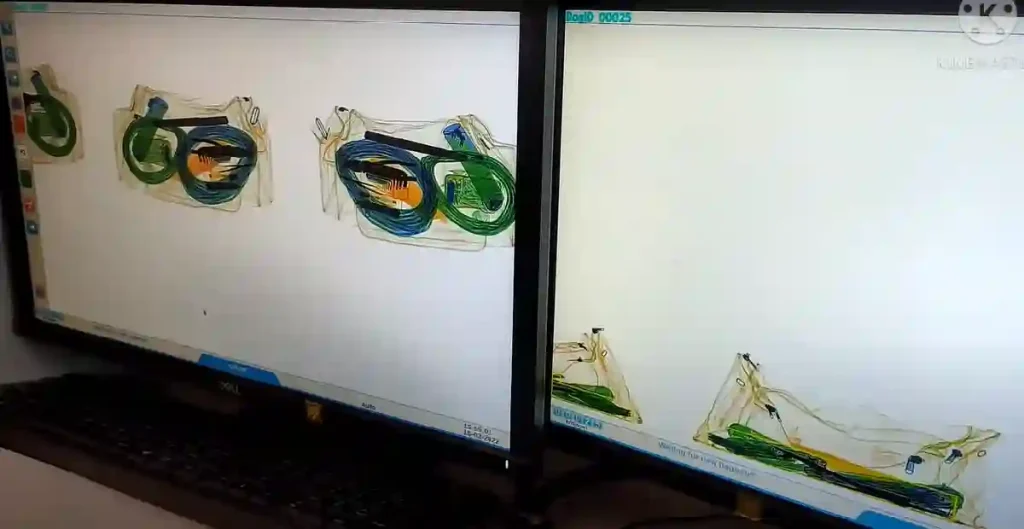
Airport security scanners are also among the important tools used to ensure the safety of passengers and crew members by screening for prohibited items, such as drugs, explosives and weapons. So, to understand how do airport scanners detect drugs in luggage, you have to be aware of the types of airport security scanners and how they work. The most common types of security scanners used in airports around the world are as follows:
1. X-Ray Scanners
- Functionality : Generally, X-ray scanners are used for luggage screening. They emit X-rays that pass through the baggage and form images depending on the density of items contained within. These scanners create two-dimensional images for security staff to examine for suspicious items.
- Applications: X-ray scanners are typically located at check-in counters and security checkpoints, where they analyze carry-on luggage and checked baggage.
2. Computed Tomography (CT) Scanners
- Data acquisition (i.e., already dated) CT-scanners show the subsection contents of the luggage in high resolution 3D images, and can be viewed from different points of view. This ability allows security staff to identify hidden objects more easily.
- Automated Threat Detection: A number of CT scanners are equipped with integrated software, allowing them to automatically detect the elements and threats in the image, thus minimizing the need for manual threat interpretation. Due to its success in detecting drugs and other illegal substances, there is a growing trend of using this technology at airports.
3. Millimeter-Wave Scanners
- Non-Invasive Detection : Millimeter Wave scanners work by emitting energy-frequency waves that penetrate clothing and enable detection of concealed items beneath. They are the kind of scanners used to screen individual passengers.
- Privacy Features: Newer millimeter-wave scanners include privacy features that prevent detailed body images from appearing on the display, instead identifying regions of the body in which potential threats might exist [82, 84].
4. Backscatter X-Ray Scanners
- Automated Exterior Profiling: Backscatter X-ray scanners employ low dosages of X-rays to generate images of the exterior of a passenger and their effects Automating Critical Data Capture They work by sensing scattered X-rays that bounce off the skin and clothing, revealing concealed objects.
- Use cases: These scanners have been used for passenger screening but have fallen out of favor due to privacy concerns and the adoption of less invasive technologies.
5. Trace Detection Systems
- Particle Analyzing: These processes focus on detectability of minute traces of explosives or drugs. These systems rely on a procedure known as ion mobility spectrometry (IMS) to examine samples of air or swabbed surfaces for the presence of specific molecules associated with drugs.
- Rapid feedback: Trace detection systems generate feedback quickly, which means they can be used to secondary scan bags or personal effects that have been identified by other detection technology in the process.
6. Terahertz Scanners
- Emerging Tech: Terahertz scanners use terahertz radiation to pass through clothing and packaging materials and identify an object’s molecular makeup. This technology is normally good at detecting organic material, and that includes drugs.
- Safety: Terahertz radiation is non-ionizing, which allows it to be safely used on people and baggage with no risk to their health.
7. Handheld Scanners
- Portable Detection: Handheld scanners for instant inspections of bags and travelers. They scan certain areas for traces of drugs and explosives, providing instant feedback to security organizations.
- Flexibility: These portable scanners can be especially helpful in locations where extensive scanning infrastructure might not be practical, like at smaller airports or during periods of increased risk or alert.
8. Drug-Sniffing Dogs
- Canine Units : Although they are not scanners per se, drug-smelling canine units are an essential and cost-efficient method of drug detection at airports. These specially trained dogs are able to detect certain odors specific to certain narcotics and alert their handlers to a possible threat.
- Supplemental Application — K9 units frequently operate in conjunction with different scanning innovations to improve general security and viability in distinguishing imperceptible medications.
How Do Airport Scanners Detect Drugs?
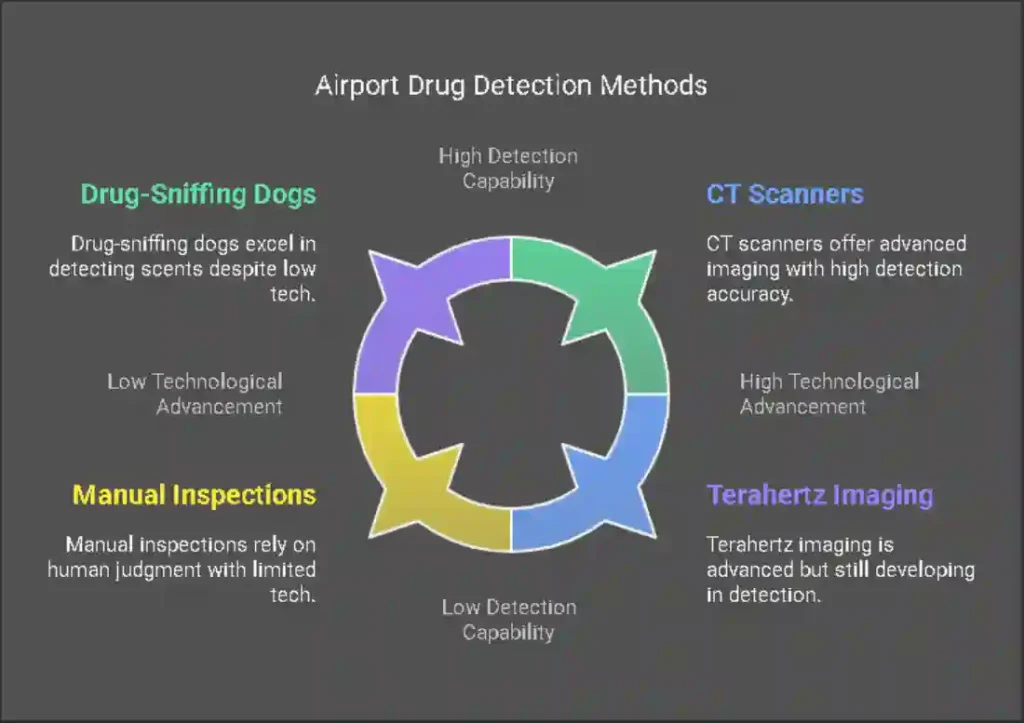
Airport scanners are vital in ensuring the safety and security of air travel by finding illegal substances such as drugs. To understand how do airport scanners detect drugs in luggage, we need first to have a glance at the different technologies and methods of security screening methods. Here’s a closer look at the methods and technologies used to identify drugs at airports.
1. X-Ray Scanners
- Text:keyFunctionsInherent: Conventional X-ray scanners operate by transmitting X-rays through bags and recording the images captured. These images, in various shades of gray, show bag contents that security can use to identify several materials based on type and density.
- Drug-Like Material Detection: Different drugs will typically possess different densities and shapes which will show differently under X-ray imaging. Security had been trained to look for patterns that are indicators of narcotics—produced in interesting packaging, among Other people with concealed content material, and many others.”
2. Computed Tomography (CT) Scanners
- Enhanced Image: CT scanners spark detailed three-dimensional photographs of what the luggage contains, exhibiting an extensive overall look at the things from myriad angles. This enables security personnel to check on the items without needing to unpack the bags physically.
- Automated threat detection: Most CT scanners already have automated threat detection systems that use algorithms to identify suspicious items. These algorithms examine the shape, density and material composition of scanned objects and are designed to draw attention to possible drug-related threats.
3. Trace Detection Systems
- How They Work: Trace detection systems are meant to pick up tiny particles of drugs that can linger on surfaces or in luggage. These methods frequently employ ion mobility spectrometry (IMS), a technique that screens air samples from the vicinity of luggage for specific chemical signatures linked to drugs.
- Ability to Spot Things: Trace detection can detect most narcotics e.g. heroin, cocaine, and synthetic drugs even in some amount. Operators will be able to swipe the surfaces of briefcases with wipes or run handheld detectors over air samples, improving the chances of detecting hidden drugs.
4. Millimeter-Wave Scanners
- The non-ionizing: Millimeter-wave scanners that are usually used for traveler screening. They emit low-energy millimeter-wave radio frequency signals that penetrate clothing and identify concealed objects. This technology works well for detection of under-clothing items — drugs included.
- Privacy Features : Newer millimeter-wave scanners incorporate hidden features, such as automated threat detection that electronically scrambles images of passengers, ensuring security workers do not see detailed images of people’s bodies.
5. Terahertz Imaging
- Emerging Technology : Terahertz imaging is still an evolving technology which uses terahertz radiation penetrating materials to provide information on their molecular makeups. It can accurately detect organic substances such as drugs, following their unique molecular signatures.
- Terahertz imaging is safe, and no health hazards to travelers have been reported, which makes it a potential future tool for drug detection at airports.
6. Drug-Sniffing Dogs
- A Highly Trained K-9 Unit : Airports use drug-sniffing dogs trained to detect certain smells related to narcotics. These canines sniff out drugs in bags, in cargo, and on passengers.
- Active Alerts : When a dog alerts (say, sits or paws at a bag), it triggers closer inspection by security personnel, who might employ extra processes to verify the drugs are present.
7. Manual Inspections
- Human Assessment: Security personnel can keep conducting manual inspection of baggage in circumstances when scanners sound alarms. This may involve rummaging through stuff, opening secret compartments, and checking packages that look suspicious.
- Identification of Smuggling Methods : In drug detection work, experienced security staff can often spot simple re-s smuggling methods, including the concealment of drugs in electronic equipment or personal items.
Advanced Technologies Used to Detect Drugs
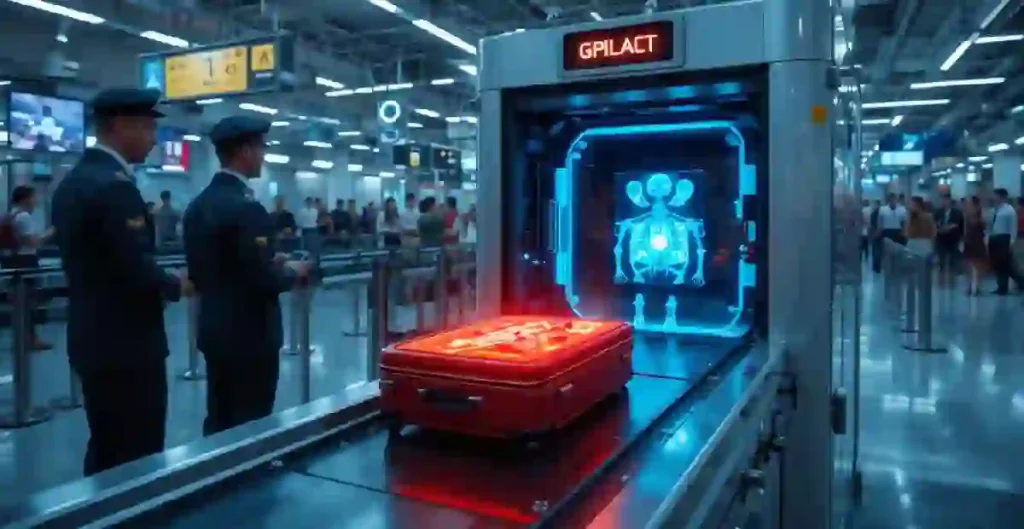
Indeed, advanced technologies have proven to be key to countering the ever-changing smuggling system, as airport security faces fresh drug evasion threats amid drug detection becoming more effective. These are among the most useful tools for detecting drugs in baggage.
1. Trace Detection Systems
Traces detected with ion mobility spectrometry: Trace detection methods based on ion mobility spectrometry allow the pharmaceuticals on the bags or surfaces to be detected even in caseof the minute traces. These systems “sniff” the air surrounding the bag, assessing chemical signatures that suggest the presence of narcotics. The technology is so sensitive, in fact, that it can detect minute traces of matter that aren’t visible to the naked eye.
2. Computed Tomography (CT) Scanners
- 3D Imaging — Unlike conventional X-ray scanners, CT scanners produce detailed 3D images of the contents of the bag. This enables security officials to scrutinize the construction and layers in the luggage, exposing drugs concealed in pockets or inside other items.
- Automated Threat Detection: Most CT scanners include some form of artificial intelligence that helps automate the detection process. These systems are advanced enough to detect and flag possible threats without having them done by humans, which can make the process even quicker while still varying accuracy.
3. Terahertz Imaging
- New Methods for Fingerprint Detection: Terahertz imaging, for example, is a relatively new technique that identifies materials using their unique molecular structure. Drugs are organic compounds, and they have unique molecular fingerprints that this technology can detect. It is also non-invasive and might build detection accuracy with no manual searching.
4. AI and Machine Learning
- Pattern Recognition : Embedded AI analyzing scanners can recognize patterns in baggage that suggest concealment of illegal drugs. A machine learning model is trained on thousands of images to identify suspicious items — aiding security staff in targeting high-risk bags.
As these high-class technologies continue to roll out and become more popular, drug smugglers will find it harder and harder to get around airport security. Note that all the tools together help in understanding how do airport scanners detect drugs in luggage and add to the air journey safety.
Manual Methods for Detecting Drugs
Though airport drug detection relies on advanced technologies, manual processes still form an integral part of the process. Those practical methods provide an extra layer of security, to ensure that no potential threat passes through. Here’s a look at those and other methods that worked best manually, at airports.
1. Physical Luggage Inspections
- Hand-Searches: If suspicious items are flagged by airport scanning, a manual search of the suitcase by security will occur. This requires unpacking the bag, including areas where items can be hidden, such as false compartments or hidden pockets. Physical searches are one of the last stages of the bag being flagged during scanning.
- How To Detect Smuggling Techniques: Well-trained security staff can identify simple smuggling methods, including things that have been hollowed out, tapered seams, or materials hidden with personal items. Such manual inspections can find drugs that technology may not catch.
2. Drug-Sniffing Dogs
- SEek instead highly Trained K9 Units : Airports Use special learned dogs to detect drugs regularly These narcotics dogs can detect particular smells connected with illegal drugs even in small amounts. Their acute sense of smell allows them to detect drugs that are buried deep in bags, behind containers, and even on visitors.
- Active and Passive Alerts Depending on their training, dogs will give either an active alert (barking or scratching) or a passive alert (sitting or standing still) when they detect drugs. This enables handlers to enable scrolling and double check that illegal ingredients are present.
3. Passenger Behavior Observation
- Behavioral Detection Officers : In some airports, providers are trained to watch travelers for signs of suspicious behavior. These officers receive advanced training at detecting nervousness, odd movements or other cues that a person may be smuggling drugs. Their observations frequently result in additional screening or searches.
- Passenger bag checks : Sometimes visitors can be interviewed by the officials if they seem suspicious or violate the system of travel. These interviews, along with background checks and detailed questioning, do help to uncover smuggling attempts.
4. Swab Testing
- Detection of Drug Residue: In certain cases, the baggage or personal items may be assaulted with a swab test. It is a piece of cloth that wipes surfaces, after which the sample is analyzed for drug traces with the help of specific equipment. Even tiny traces of narcotics are traceable, hinting that drug smuggling is occurring.
Limitations of Airport Scanners in Detecting Drugs
In fact, while there is beautiful technology on the airport scanners to identify the threats, there are limitations to how do airport scanners detect drugs in luggage. These limitations have to be understood to enhance security and to plug the gaps in detection mechanisms.
1. False Positives and False Negatives
- Erroneous Alerts : Scanners can occasionally detect safe items as suspicious, causing delays and handheld search processes. X-ray images of organic materials such as cosmetics or even food might have a similar appearance to drugs, leading to confusion.
- False Negatives: Airport scanners may in some instances fail to detect drugs, especially, for example, if they are hidden in very high tech systems or in areas where the scanner cannot fully penetrate. Smuggling techniques are constantly adapted by criminals, making it difficult to catch every threat.
2. Limited Detection of Concealed Drugs
- Swap — Internal Smuggling : The ingestion or insertion into body cavities of drugs is difficult to detect with the standard X-ray scanners, or millimeter-wave scanners, that are used to search suitcases and scan human bodies.
- Sophisticated Concealment Techniques: Some smugglers employ complex concealment methods, such as encasing drugs in objects, liquids, or sealed containers that could potentially evade conventional scanning. Though sophisticated technology, such as CT scanners, can detect these, nothing is foolproof.
3. Dependence on Operator Skill
- Human Error: No matter how high-tech, scanners require trained personnel to read the images correctly. Such drama is not because of you actually winning but just the fact that you are a lot bigger and everyone knows that.
- Variable Screening Performance : some airports may not train their security personnel for drug detection as effectively as others These inconsistencies can create blind spots at certain checkpoints.
4. Evasion Techniques
- Drug Coating and Packaging: Smugglers routinely coat drugs with substances that can disguise their appearance or odor, making it more difficult for standard X-ray or trace detection methods to catch them.
- Small Amounts: Scanners can find drugs in large quantities, but very small well-hidden quantities mixed in with other benign objects may not always be detected.
Differences in Airport Security Around the World
Airport security can vary widely by region and country, including the types of technology utilized and the methodology of how do airport scanners detect drugs in luggage. These differences are in response to local security concerns, regulations and resources in each country.
1. Stringency of Security Measures
- United States : Airport security in the USA: It’s well known that US (especially TSA) security is strict and very thorough. The United States has a wide variety of technologies at its airports — including CT scanners, trace detection systems, and body scanners — that can spot drugs and other illegal substances. The focus on high technology answers is in rebuttal to both global and national security threats.
- European Union : Europe has a greater sense of balance, with a high level of security but not the invasive approach of the U.S. Countries like the UK and Germany employ X-ray scanners, millimeter-wave scanners, and drug-sniffing dogs extensively. Then again, there are more secret rules that may signal the partial ban of full-body scanners in some places.
- Asia: Airports in countries such as Singapore and China are fitted with the latest technology, and security is extremely rigorous, especially in countries that are home to major international hubs. Asian airports seem to be colluding facial recognition and other AI-dependent scanning techniques for both efficiency and accuracy in drug identification.
2. Technological Infrastructure
- Developed Vs Developing Countries : Airports in developed countries are equipped with the latest technologies such as terahertz imaging, CT scanners, and AI-powered threat detection systems. These modern tools help to better identify drugs. In contrast, some developing countries still use standard X-ray machines at the airport, and cannot pinpoint concealed drugs as specifically as the new mini-CT systems.
- Regionalism : Certain areas, like the EU, enjoy intercrossing collaboration and close security ideals across member nations. This allows for the sharing of technology, intelligence and all resources, which improves drug detection.
3. Cultural and Regulatory Differences
- Privacy Concerns : In Europe and parts of Asia, privacy laws are stricter, so technologies such as full-body scanners are used sparingly or with limitations to protect personal rights of travelers. In contrast, the U.S. and countries like it favor security over privacy in domains like the airport, and grant permission for invasive scanning and inspection.
- Legal Enforcement: The laws related to drugs and trafficking vary from country to country. For instance, in several Middle Eastern nations, just small amounts of drugs are sufficient for harsh punishment, and security practices are similarly stricter. On the other hand, alternative countries with slacker drug prohibitions may not spend as much resources on weed spotting on the airfield.
4. Focus on Specific Threats
- Terrorism vs. Drug Trafficking : Airline security in places like Israel is mainly concerned with terrorism and involves heavily trained personnel and sophisticated behavioral analysis techniques. Drug detection — yes, that’s still a priority, but the elementary focus is still making sure you aren’t a terrorist. By contrast, nations in Latin America, where drug trafficking is a far bigger concern, frequently pay more attention to scanning for narcotics, opening bags and using both high-tech tools and the human eye.
5. Deployment of Manual Methods
- Drug-Sniffing Dogs : In much of the world, including Latin America and Southeast Asia, drug-sniffing dogs are a key part of drug detection. In addition to scanners, these dogs are used to increase security. However; on the other hand, some European countries would rather depend on technology than manual processes such as K9.
- Security Checks : In certain nations, security officers depend on manual checks of bags and people because of lack of high-level scanning technology. This process remains widely adopted in areas where drug trafficking is an acute issue, but budgets for sophisticated imports may be limited.
Common Myths and Misconceptions About Airport Scanners
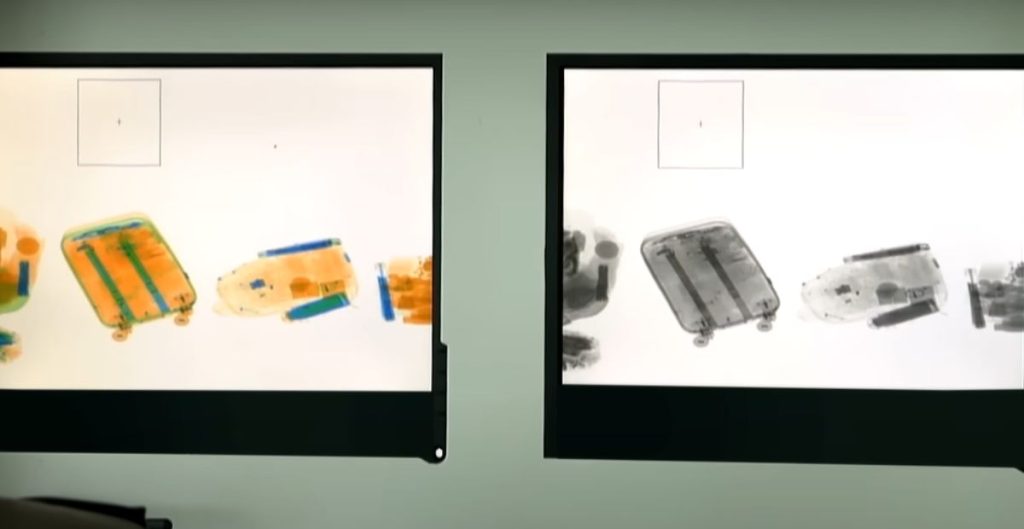
Even though airport scanners are used in all airports there are lots of myths about how they work, mostly as generalised beliefs on how do airport scanners detect drugs in luggage. Setting the record straight on these points will help passengers better understand airport security and how the technology works.
1. Myth: Airport Scanners Can See Everything in Detail
- Reality: The airport scanners, with regard to the X-ray scanners to be more specific, produce a clear image of the contents inside a baggage but this means not everything can be displayed with full clarity. The images produced are often color-coded by the material’s density, so certain objects might seem fuzzy or amorphous. Security staff have to interpret these images methodically to differentiate possible threats from ordinary objects. Substances might not reveal themselves immediately without deeper investigation.
2. Myth: Airport Scanners Can Detect Drugs Hidden Inside the Body
- Reality : Most airport scanners, such as X-ray machines for suitcase or millimeter-wave scanners for passengers, cannot detect drugs concealed inside the body. Internal smuggling, where drugs are swallowed or inserted into body cavities, normally nerds specialized equipment like medical scanners (CT or MRI) or physical searches. While full-body scanners can detect items secret under clothing, they are not designed for internal drug detection.
3. Myth: Wrapping Items in Foil or Plastic Will Fool Scanners
- Reality : Most airport scanners, like X-ray machines for luggage or millimeter-wave scanners for people, cannot detect drugs hidden in someone’s body. Internal smuggling, whereby drugs are swallowed or inserted into body cavities, typically nerds specialized equipment like medical scanners (CT or MRI) or physical searches. Although full-body scanners are adept at detecting concealed over-clothing items, they are not intended for use on narcotics hidden internally.
4. Myth: All Airport Scanners Are Invasive
- Myth: Wrapping drugs or other items in foil or plastic helps them avoid detection. 42 Ox; and fails to raise suspicion.” (emphasis mine) X-ray scanners can identify different materials, so anything that looks suspicious such as something wrapped in foil will be flagged for further inspection. Smugglers do this a lot, but security staff are trained to spot such tactics.
5. Myth: Drugs Can Easily Be Masked by Other Substances
- In reality: Not all airport scanners take invasive images or subject passengers to large doses of radiation. For example, millimeter-wave scanners use non-ionizing radiation, which is completely safe and not a health hazard. X-ray scanners for luggage scannings are designed for the contents of the baggage, not for the people. While full-body scanners do produce a detailed image of the body, newer models blur the personal areas and use automatic threat detection to minimize human review of images.
6. Myth: Airport Scanners Are Perfect and Never Miss Anything
- Myth : Some think that concealing drugs inside of other things (like clothing or food) will prevent them from being discovered by your po-po. But airport scanners are built to find all kinds of materials, including organic materials such as drugs. Trace detection technology and drug sniffing dogs are still able to identify drugs based on chemical composition or scent, no matter how well they are hidden.
7. Myth: All Airport Security Is the Same Everywhere
- Reality : security process, and the type of scanners used, can vary tremendously from airport to airport and country to country. Others rely on traditional X-ray machines, while some airports are already rolling out more sophisticated technologies such as 3D CT scanners or terahertz imaging. Drug detection comes down to what equipment and training there is in each airport.
Emerging Trends in Airport Drug Detection
SABRENTTERRORIST SMUGGLING: HIS ORIGINS The saber — as in terror saber — is new technology, a recent and growing trend in the workplace. Read: 10 Trends for New Ways to Know How Plane Scanners Only Detect Drugs in Luggage These trends are emerging as the future of airport security all around the world.
1. Artificial Intelligence and Machine Learning
- AI Automation: AI is being used to work with airport scanning technologies to help automatically detect drugs. Algorithms may also be trained using data as far back as October 2023, so they can sift through piles of images and find patterns that suggest drugs may be stashed somewhere out of sight. These algorithms continuously evolve as they process more data, allowing them to detect faster and more accurately.
- Predictive Analysis : AI tools are being used for the prediction of smuggling systems as per travelers travel pattern and other data. Based on an assessment of historical incidents and passenger profiles, AI may be used to profile high-risk travelers for more in-depth screening.
2. 3D Computed Tomography (CT) Scanners
- High-Resolution Imaging : CT scanners are quickly becoming the new standard for airport security, exceeding conventional X-ray machines in many airports. The devices produce detailed 3D images of baggage contents, enabling security personnel to see objects from multiple angles and detect drugs stashed in elaborate ways, such as inside electronics or hollow objects.
- Advanced Automation: Most CT scanners come with the functionality of automated detection procedures that can cut down human error and boost throughput by pinpointing areas of interest for further analysis.
3. Terahertz Imaging
- Non-Invasive Detection: Terahertz imaging is a new type of technology that uses terahertz radiation to penetrate suitcases and show their molecular composition. As drugs have unique molecular structures, terahertz scanners can detect them without needing invasive searches. The technology is still experimental but shows promise for identifying clandestine materials more accurately than conventional processes.
4. Enhanced Trace Detection Systems
- Enhanced Sensitivity : More sensitive and able to detect even the faintest traces of narcotic materials, improved trace detection procedures that “sniff out” minute quantities of drugs are also making these tools more effective. Some of these procedures, which utilize technologies such as ion mobility spectrometry, are capable of identifying drugs that are too well-hidden or too faint to be detected in the past.
- Enhanced Substance Diversity : There are newer iterations of trace detection systems being developed to detect an ever wider range of substances, including newer synthetic drugs. These systems can also learn new drug formulations as they are developed.
5. Portable Drug Detection Devices
- On-the-Go Screening : Security personnel are increasingly relying on portable drug detection devices capable of real-time examination of suspicious materials. Code-named the “Drugalyzer,” these devices are able to detect small residue amounts from drugs on suitcases, textiles and even the skin. They are especially useful in places where bigger scanners are not practical, like smaller airports or border crossings.
- Immediate Results: These devices provide real-time results and minimize the need for lengthy lab procedures. Portable detection tools are increasingly accurate and available, offering an extra level of protection.
6. Biometric Integration
- Facial Recognition and Drug Profiling : Facial recognition and other biometric technologies are being combined with existing airport security processes to monitor travelers and detect abnormal behaviors. When integrated with AI and drug profiling data, these systems flag passengers who fit smuggling profiles and allow for targeted screening and reduced delays for other travelers.
- Cross-Border Cooperation : As biometric processes are increasingly adopted, they allow for greater info-sharing between nations, making it easier to track alleged drug traffickers across boundaries.
7. Collaborative Global Databases
Real-time Information Sharing : Many airports and security agencies across the globe are working towards collaborating on real-time data sharing to impose drug detection work. Countries must promote multinational coordination by sharing intelligence on smuggling trends, profiles of repeat offenders, and the details of new concealment techniques in order to coordinate efforts and develop detection rates of similar caliber across international borders.
Big Data Analytics : Big data analytics could be integrated through global databases to identify patterns of drug smuggling quicker. This information can be leveraged by security agencies to improve the quality of their screening process and adapt to the newer trends of drug smuggling,” Raju notes.
Frequently ask questions for how do airport scanners detect drugs in luggage
What Happens When Airport Scanners Detect Drugs?
If airport scanners do spot drugs, here is what typically happens next:
Flagging Passengers: The scanner will alert personnel if a clip is found.
Manual Search: Security staff will conduct a full manual search of the flagged item, checking for any hidden compartments or suspicious packages.
Trace detection: If necessary, trace detection devices may be utilized to verify drug presence through chemical analysis.
What Happens if Drugs are Found: If drugs are found in the hostims car, the police may be involved and may take arrest.
Interviewing : Interviewing the passenger about the material that is being detected.
What Happens If Drugs Are Found in Your Luggage?
If drugs are found in your luggage, the following generally occurs:
They can detain you: Airport security or law enforcement officers can detain you for interrogation.
Investigation: Law enforcement will continue to investigate the number and type of drugs and if you knew about their presence.
Legal Repercussions : You may be charged with a crime, depending on the type and quantity of drugs involved, resulting in fines, jail time or both.
Seizure: The drugs will be seized, and you may also lose any paraphernalia associated with them.
Reporting: The documents will be on file, and information could be provided to future travel, potentially conceivably affect future emirates.
What Travelers Should Know About Airport Security?
There are a few things travelers should understand about airport security:
Arrive Early : Allow for ample time to get through security screening, especially around busy travel times.
Know the Rules: Understand the banned-in-this-post items, like liquids, drugs and pointy objects to avoid confusion.
Get Ready to Be Screened: Remove belts, shoes and jackets; take laptops and liquids out of your bags for inspection.
Don’t Panic and Comply: Listen to any directions given by security staff and be courteous and even-tempered when it comes to screening procedures.
Know You May Be Randomly Screened : Remember, extra screening methods, including manual assessments and questioning, can also take place at random.
Learn About the Privacy Features — Be aware that newer scanners incorporate technologies that strike a balance between confirming safety and respecting traveler privacy.
Travel Docs: Have your ID and boarding pass out to help speed up the scanning process.
Can You Bring Medicine Through Airport Security?
You have to get your medicine through the airport security. These are some key takeaways to know:
Prescription Medications : Carry prescription medications in their original packaged labelled with your name and prescription information.
Over-the-Counter Medications : You may take over-the-counter medications, but you should keep them in their original packaging if possible.
Liquid Medications : Liquid medications are not subject to the usual 3.4-ounce rule and may be larger. You need to declare them to security agents to be checked.
Notify Security: If you have a large amount of medication or special medical devices, notify the security personnel during screening to ease the process.
Travel Documentation : If you are taking controlled substances then do keep a copy of your prescription or doctor’s note to avoid any complications.
Do Airports Use Dogs to Detect Drugs?
Yes, airports use dogs to sniff out drugs. Here are some key points:
Specially trained K9 units: Airports use specially trained dogs (K9s) that have very sensitive sniffers and can be trained to recognize specific smells associated with certain drugs.
One way is through Efficient Screening : As drug-sniffing dogs are supplemented into security screenings (for baggage, cargo, and even passengers), they offer a quick and effective means of identifying hidden substances.
Active Alerting: When a dog alerts for a specific article of property, it will cause count on inspection by security personnel, thus enhancing the opportunities of discovering illegal drugs.
K9 units have a complementary role: canine detection teams are used alongside other scanning technology to bolster airport security measures for drug detection.
Are Airport Scanners Different in Other Countries?
Yes, airport scanners can vary from country to country. Here are some key points:
Technology Differences: The types of scanning technology, from X-ray, computed tomography (CT), and millimeter-wave scanners to name a few, vary with available resources and differences in security policies across different countries.
Screening Procedures: There are differences in the security process and protocols, including how luggage and passengers are screened, the amount of manual inspections performed, and the level of use of trace detection procedures.
Regulatory Framework: There are different regulatory frameworks in place pertaining to airport security in every country, which also results in the scanners used and where they are placed at the different airports quite variable.
Risk Assessments : The security needs for any particular country are usually dedicated to that country and thus vary from region to region in the use of scanners and their implementation.
Passenger Experience : These differences can affect the experience for passengers, who in some countries were subjected to more rigorous security checks than others.
How to Properly Pack Medication and Legal Substances?
Here’s how to pack medication and legal substances for air travel:
Store Medications in Their Original Containers
Labeling : Ensure that all medications are in original containers with your name, dosage details, and prescription information clearly displayed.
Always Keep a Copy of Your Prescription
Docs: Have a copy of your prescription or a doctor’s note with you, especially for controlled substances, so you don’t run into trouble at security.
Keep Medications in Carry-On Luggage
Accessibility : Either way, pack medicines in your carry-on bag to ensure that they are easily accessible during the flight and if your checked luggage ends up missing.
Declare Liquid Medications
ENCUBES : If you’re carrying liquid medications larger than the usual 3.4-ounce limit, tell the security agent at the checkpoint for possible inspection.
Don’t Make Your Medication Compete with Other Things
Get Organized: The medicines should be separated in a different pouch or baggage so the security personnel can see to check it without mixing it up with the other things.
Familiarize Yourself with Drug Enforcement Authorities
Research : Regardless of controlled substance laws, be aware of the legal precedents regarding them that exist in the country you are visiting, laws differ from country to country or state to state.
Store Medications Safely
Heat Avoidance : During the tour day ensure that the medications are stored in a cool and dry place to conduct its potency and prevent being subjected to extreme temperatures.
Consider Travel Size
Quantity: Pack just the quantity of medicine you’ll need for your trip plus a few days’ worth, in case of delays.
To conclude, the way airport scanners identify medications in bags is a complex, layered process that uses various high-tech technologies and processes specifically developed for making air travel safer. Scanners range from X-ray and computed tomography (CT) scanners to terahertz imaging and trace detection systems, and each type of scanner is a critical instrument for detecting prohibited items concealed in a suitcase. Artificial intelligence and machine learning will aid in increasing the accuracy of detection, allowing for faster detection of possible threats.
In addition, the deployment of trained drug detection canines and hand inspections also supplement these technologies, providing a holistic security strategy that responds to the constantly changing strategies used by traffickers. As airport security has to evolve continuously to tackle new calls for, breakthroughs in scanning technology will be instrumental to ascertain the safety of passengers with minimal risk to the competence of airport operations. These rules define airport security for fliers, but knowing them should also highlight how good measures are taken to prevent drug smuggling and improve the safety of air travel.
